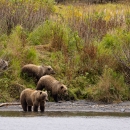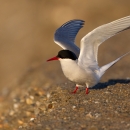States
AlaskaThe Kodiak archipelago is home to both Aleutian and Arctic tern colonies. Aleutian terns are distributed widely across remote areas of coastal Alaska and frequently shift their colony locations from year to year, making it difficult to monitor and research this little known seabird. Arctic terns are circumpolar, and nest both inland and along the coastline of Alaska. Over the past three decades, colony surveys of both species along the coast and at sea indicate an over 90% decline in population.
Aleutian terns in Kodiak have declined since the 1970's. The four largest colonies that once supported between 240-3000 individual terns now have significantly reduced numbers and intermittent use, with 2014-15 counts ranging from 0-25 terns. Recent intensive surveys suggest that Aleutian terns have declined rather than relocated within the archipelago.
Surveys and colony monitoring can help us gain valuable insight into Aleutian tern ecological requirements, breeding biology, and possible reasons for population declines.
Contact Kodiak National Wildlife Refuge
Find more information about past surveys and current Refuge monitoring projects in these reports and posters:


